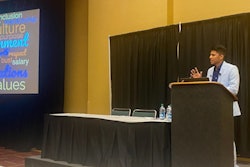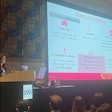CHICAGO -- More than one-third of female radiologists experience female-to-female aggression in the workplace, according to research presented November 28 at the RSNA 2023 annual meeting.
In her talk, Ami Gokli, MD, from Children’s Hospital of Philadelphia, shared study results indicating that about 36% of women surveyed indicated exerting this behavior on other women, a phenomenon known as "pink-on-pink" aggression.
“We hope that characterizing the extent of this experience will raise awareness and may help prevent it,” Gokli said.
Previous studies have analyzed this type of aggression in the workplace, though these have focused on nursing and nonhealthcare settings. The behavior consists of a woman with higher power status degrading, ridiculing, or undermining the work of a woman with less power. Such behavior may hinder the career goals of junior female radiologists. However, Gokli said that senior women may or may not be aware of their role in carrying on this behavior.
The Gokli team analyzed such trends among radiologists, using survey data collected in 2022 from 199 members of the Society of Pediatric Radiologists. Of these, 73% were female, 27% were male, and 0.5% were nonbinary. Respondents ranged from in-training physicians to those with more than 21 years in practice across an age range of 25 years to more than 66.
The researchers found that of all respondents, nearly half -- 47% (n = 93) -- indicated being personally on the receiving end of pink-on-pink aggression, while 68% (n = 135) had witnessed such behavior. They also found that 36% (n = 71) of respondents admitted to exerting this behavior on other women.
 Ami Gokli, MD, from Children's Hospital of Philadelphia, presents survey findings describing the rate and impact of female-to-female aggression, also known as pink-on-pink aggression.Amerigo Allegretto
Ami Gokli, MD, from Children's Hospital of Philadelphia, presents survey findings describing the rate and impact of female-to-female aggression, also known as pink-on-pink aggression.Amerigo Allegretto
The team also reported that while most respondents agreed that such behavior is limited to a few people, 39% (n = 76) ranked pink-on-pink aggression as a middle or top cause of job-related stress and tension. Additionally, 46% (n = 88) indicated that it had changed or affected their career path.
The top reasons for not reporting such aggression included fear of being accused of misogyny, fear of being perceived as the person with the issue, and fear of retaliation.
Finally, the researchers found that 76 respondents included descriptions of aggression experiences and 109 had suggestions for solving this problem.
Gokli suggested that the cause of such behavior by women of higher power may be the product of overall gender inequality in society.
“Studies have shown that this can be a way that women cope with gender discrimination that they have faced in their careers,” she said. “Women who experience bias may begin to emphasize how different they are from other women. And they may begin to apply those same gender stereotypes that they have encountered.”
Gokli added that the only way to address and tackle this problem is to change the work environment. This includes helping women through mentorship, advocacy, and creating opportunities. Gokli also suggested that people should offer to help their female colleagues in need, publicly amplify women’s hard work, and collaborate to address work needs.



















